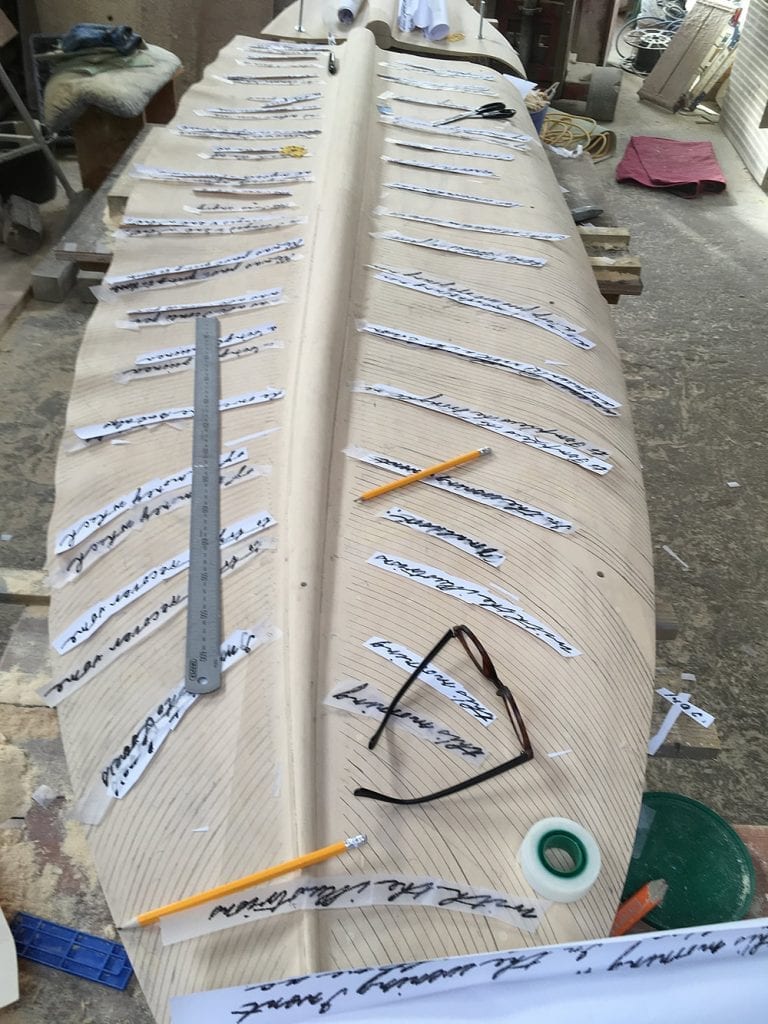In 2020 The Boswell Trust erected a bronze feather writing quill in Auchinleck graveyard. Commissioned in 2016, the original artists’ brief was to create a landmark and orientation point for visitors to Auchinleck’s historic graveyard that would balance the tall gothic war memorial alongside it in the re-landscaped oval of lawn between the new and old churches. From an invited shortlist, the sculptor, Harry Gray, came up with the winning idea of a Quill, producing a quick sketch drawn from an actual goose feather. The 4.2m high Quill leans against a Scottish pink sandstone inkwell topped with a circle of slate that turns black as ink in the rain. “From the outset” Gray recalled, “I was confident that my sculpture would be about the creative act of writing itself rather than the usual traditional figurative response.”
Temple and his brother breakfasted with me.
I went to Love’s to try to recover some of the money which he owes me. But alas a single guinea was all I could get.
He was just going to dinner so I stayed and eat a bit,
though I was angry at myself afterwards.
I drank tea at Davies’s in Rufsel* Street and about seven came in the great Mr. Samuel Johnson, whom I have so long wished to see.
Temple and his brother breakfasted with me.
I went to Love’s to try to recover some of the money which he owes me. But alas a single guinea was all I could get.
He was just going to dinner so I stayed and eat a bit,
though I was angry at myself afterwards.
I drank tea at Davies’s in Rufsel* Street and about seven came in the great Mr. Samuel Johnson, whom I have so long wished to see.
The Making of the Quill
The process from sketch to finished bronze involved centuries-old techniques which date back to classical times. Taking the goose feather as his proto-type, Gray first carved a 1:5 scale model in lime wood before carving full size sections for casting in bronze. Due to its monumental scale, the carvings were pressed into hard-drying sand to create accurate moulds for the casting in molten bronze. From his Cambridge studio Gray wrote of the next stage of the process: “I began work on the ‘raw’ bronzes, shaping the grooves of the barbs using handheld power tools to sculpt the material into the finished forms.”
The Sculptor
Harry Gray, born in 1963, has been based at his studio in Cambridge for the past 30 years. He first came to prominence at the turn of the twentieth century as one of the select carvers for the internationally renowned Scottish conceptual artist and poet, Ian Hamilton Finlay.
Gray, like Hamilton Finlay, is a conceptual artist, inspired by language, typography, symbol, and allegory, which he mines for layers of meaning in response to particular commissions. As a sculptor, he transforms these ideas into solid reality through his skill as a designer and multi-disciplinary maker, marrying form, content, and materials to create beautiful and intriguing works of public art.
Gray’s commissions include the Battle of Britain Memorial on the cliffs of Dover; the Rose and Poppy Gates at Twickenham International Rugby Stadium; and a landscape artwork of the Reformers’ Tree in London’s Hyde Park. Prior to the Quill, his most recent commission was a series of bronze portrait medallions in the London Borough of Islington, celebrating famous inhabitants including Samuel Ajayi Crowther, a freed slave who became the first black Anglican bishop.
Acknowledgements
fsegroup.co.uk
harringtonfabrications.com
smithandwallwork.com
tlg-landscape.co.uk


